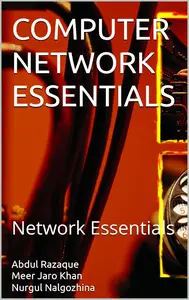
Free Download COMPUTER NETWORK ESSENTIALS : Network Essentials by Abdul Razaque, Meer Jaro Khan, Nurgul Nalgozhina
English | June 14, 2024 | ISBN: N/A | ASIN: B0D764TJWJ | 521 pages | EPUB | 3.20 Mb
Network technology is the foundation of effective communication, with computer networks driving our daily operations and providing universal connectivity. A computer network is a collection of interconnected computers that enable seamless communication, resource sharing, and coordinated functioning.
Computer networking is complex, encompassing numerous concepts, technologies, and protocols. Most textbooks structure their content around the OSI layers to help students grasp the intricacies of computer networking.
As new technologies, standards, and practices emerge, the scope of computer networking has expanded. This textbook includes network security and advanced cloud computing concepts, aligning with current market demands. It aims to build a strong foundational knowledge for learners, helping them identify potential opportunities. Computer networks are pivotal in shaping the future by providing efficient communication methods.
Due to rapid technological advancements, computer networking supports various types of communication, facilitating data exchange at community, regional, national, and international levels. This book is intended for a diverse audience, from high school students to advanced degree learners, who are interested in strengthening their knowledge and building careers in computer networking.
The textbook comprises 17 chapters, each organized to meet the needs of learners at different levels:Chapter 1 introduces fundamental concepts of networks, topologies, and communication modes.Chapter 2 covers network building concepts, including layering, protocols, and Internet architecture.Chapter 3 focuses on switching, bridging, internetwork classification, service models, ARP, IP, DHCP, ICMP, and GRE.Chapter 4 delves into advanced internetworking, routing, IPv6, addressing types, MPLS, VPN, and mobile networking challenges.Chapter 5 discusses resource allocation, congestion control, queuing types, and transmission control protocol.Chapter 6 addresses network security, covering cryptographic methods, authentication protocols, security protocols, and firewalls.Chapter 7 explores applications including web services, multimedia, infrastructure services, and overlay networks.Chapter 8 presents encoding techniques, framing, error detection, wireless technologies, and cell phone technologies.Chapter 9 details communication technologies, switching connections, multiplexing, and transmission media.Chapter 10 focuses on network standards, encapsulation, the OSI model, TCP/IP reference model, and their comparison.Chapters 11-12 describe local and wide area networks (LAN/WAN) and their protocols.Chapter 13 discusses Internet protocols, sub-netting, addressing, and examples.Chapter 14 covers queuing, scheduling techniques, and traffic supervision.Chapter 15 explores supercomputing, cloud computing, parallel programming models, and topological flow control.Chapter 16 discusses advanced cloud computing, emerging technologies, and cloud security.Chapter 17 provides insights into advanced cloud architectures and dynamic failure detection and recovery.This comprehensive textbook is designed to equip learners with the knowledge and skills needed to excel in the field of computer networking.










Leave a Reply
You must be logged in to post a comment.